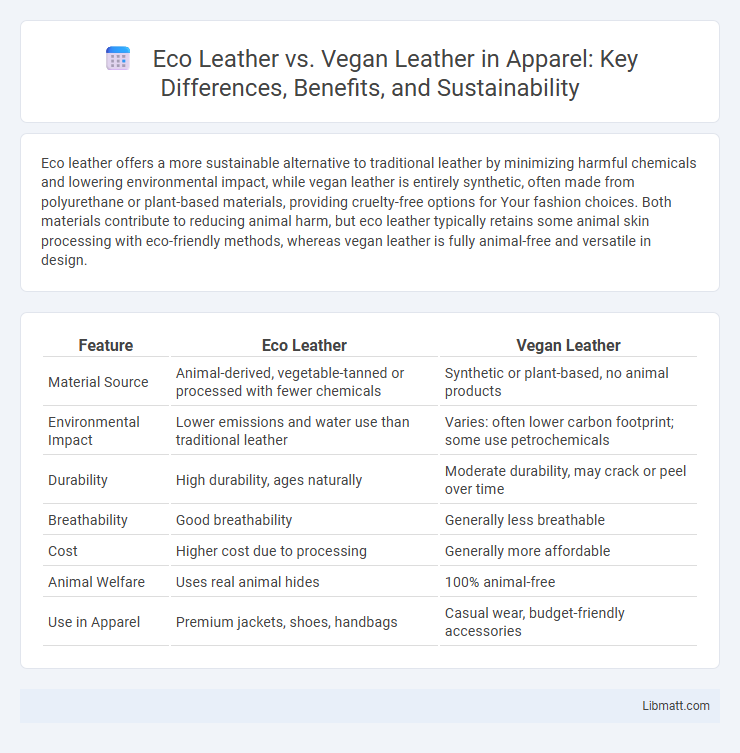Eco leather offers a more sustainable alternative to traditional leather by minimizing harmful chemicals and lowering environmental impact, while vegan leather is entirely synthetic, often made from polyurethane or plant-based materials, providing cruelty-free options for Your fashion choices. Both materials contribute to reducing animal harm, but eco leather typically retains some animal skin processing with eco-friendly methods, whereas vegan leather is fully animal-free and versatile in design.
Table of Comparison
| Feature | Eco Leather | Vegan Leather |
|---|---|---|
| Material Source | Animal-derived, vegetable-tanned or processed with fewer chemicals | Synthetic or plant-based, no animal products |
| Environmental Impact | Lower emissions and water use than traditional leather | Varies: often lower carbon footprint; some use petrochemicals |
| Durability | High durability, ages naturally | Moderate durability, may crack or peel over time |
| Breathability | Good breathability | Generally less breathable |
| Cost | Higher cost due to processing | Generally more affordable |
| Animal Welfare | Uses real animal hides | 100% animal-free |
| Use in Apparel | Premium jackets, shoes, handbags | Casual wear, budget-friendly accessories |
Introduction to Eco Leather and Vegan Leather
Eco leather is a sustainable material crafted by treating genuine animal leather with environmentally friendly processes that reduce chemical use and minimize waste. Vegan leather, often made from synthetic materials like polyurethane or natural alternatives such as cork or pineapple fibers, offers an animal-free option that mimics the look and feel of traditional leather. Understanding the difference between these two materials helps you make informed choices aligned with your ethical values and environmental priorities.
Defining Eco Leather: Materials and Processes
Eco leather is produced using sustainable materials and environmentally friendly processes, often combining genuine leather with innovative tanning methods that reduce water usage and toxic chemicals. It employs vegetable-based tannins or bio-based treatments derived from plant extracts, minimizing ecological impact compared to conventional chrome tanning. This approach ensures durability and a natural look while promoting responsible resource management and lowering carbon emissions throughout the manufacturing cycle.
What is Vegan Leather? Key Characteristics
Vegan leather is a synthetic alternative to traditional animal leather, made from materials such as polyurethane, polyvinyl chloride (PVC), and increasingly from plant-based sources like pineapple leaves or cactus. Key characteristics include its cruelty-free nature, water resistance, and versatility in design, making it a popular choice for conscious consumers seeking sustainable fashion. Your choice of vegan leather supports ethical production without compromising on style or durability.
Environmental Impact: Eco Leather vs Vegan Leather
Eco leather reduces environmental damage by utilizing sustainable tanning processes and natural materials, resulting in lower carbon emissions and less water pollution compared to traditional leather. Vegan leather, often made from synthetic materials like polyurethane or PVC, can have a higher carbon footprint and contribute to microplastic pollution, though plant-based alternatives such as pineapple or mushroom leather offer more eco-friendly options. Choosing eco leather over conventional vegan leather reduces reliance on fossil fuels and decreases toxic chemical use, supporting a more sustainable fashion industry.
Durability and Longevity Comparison
Eco leather, made from sustainable animal hides processed with environmentally friendly methods, generally offers superior durability and longevity compared to vegan leather, which is typically crafted from synthetic or plant-based materials. While vegan leather provides a cruelty-free alternative, it often lacks the strength and aging characteristics of eco leather, resulting in faster wear and potential cracking over time. Choosing eco leather ensures your products maintain their quality and appearance longer, balancing sustainability with lasting performance.
Aesthetic and Sensory Differences
Eco leather offers a natural grain texture and a supple feel reminiscent of traditional leather, providing a luxurious aesthetic and rich sensory experience. Vegan leather, typically made from synthetic materials like polyurethane or plant-based alternatives such as pineapple or mushroom fibers, presents a smoother surface with varied finishes but can sometimes feel less breathable and rigid compared to eco leather. Both materials cater to different preferences, where eco leather emphasizes organic authenticity and vegan leather prioritizes animal-free innovation and diverse visual appeal.
Ethical Considerations in Leather Alternatives
Eco leather and vegan leather differ significantly in ethical considerations, with eco leather often made from sustainably sourced animal hides treated with less harmful chemicals, reducing environmental impact while maintaining durability. Vegan leather, crafted from synthetic or plant-based materials, avoids animal exploitation entirely, appealing to consumers prioritizing animal rights but sometimes involves non-biodegradable components with environmental drawbacks. Your choice impacts animal welfare and ecological sustainability, making awareness of production processes essential in selecting a responsible leather alternative.
Cost and Market Availability
Eco leather typically commands a higher price due to its partial use of natural materials and environmentally conscious tanning processes, while vegan leather is often more affordable, made primarily from synthetic or plant-based alternatives. Market availability favors vegan leather, which is widely accessible across fashion and upholstery sectors thanks to its lower costs and growing consumer demand for cruelty-free options. Your choice between the two will depend on balancing budget considerations with your preference for sustainability and material origin.
Popular Uses and Applications
Eco leather is commonly used in high-end furniture, luxury handbags, and premium car interiors due to its durability and natural appearance. Vegan leather finds widespread application in fashion accessories, footwear, and upholstery where cruelty-free and sustainable materials are prioritized. Your choice between these materials depends on the desired texture, environmental impact, and ethical considerations.
Choosing the Right Leather Alternative
Choosing the right leather alternative depends on sustainability, durability, and ethical considerations. Eco leather, often made from natural fibers and treated with minimal chemicals, offers a more environmentally friendly option compared to traditional leather. Vegan leather, typically crafted from synthetic materials like polyurethane or innovative plant-based sources such as pineapple leaves or cactus, provides a cruelty-free alternative with diverse textures and lower carbon footprint.
eco leather vs vegan leather Infographic

 libmatt.com
libmatt.com